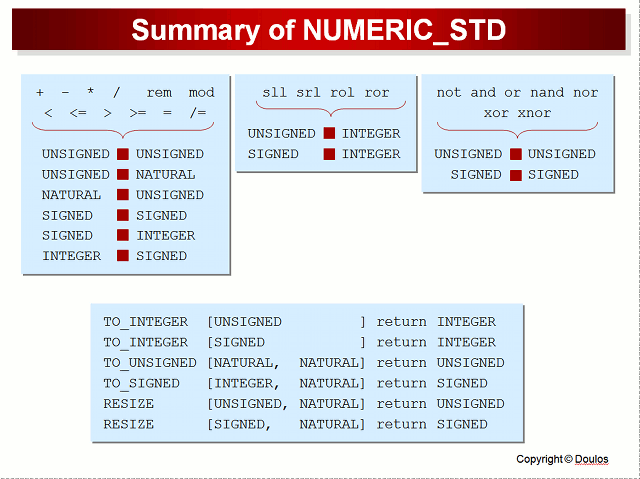Operators⚓
Assignment operator⚓
The assignment operator is : <=
1 | |
The assignation is not like in software programming setting the value of a variable stored in memory, but the electrical connection.
Logical operators⚓
The logical operators AND, OR, NOT, NAND, NOR, XOR and XNOR allow to make operations between signals of type std_logic and std_logic_vector:
1 2 3 4 5 6 7 | |
Relational operators⚓
Relational operators are used to compare the values of signals of the same type. The returned value is a boolean, used for conditional structures.
| Operator | Description |
|---|---|
= |
equal |
/= |
different |
< |
lower |
> |
higher |
<= |
less or equal |
>= |
greater or equal |
Arithmetic operators⚓
| Operator | Description | Synthesizability |
|---|---|---|
+ |
addition | synthesizable |
- |
subtraction | synthesizable |
* |
multiplication | synthesizable |
/ |
division | synthesizable if the right operand is a constant power of 2, or if both operands are constant |
mod |
modulo | synthesizable if the right operand is a constant power of 2 |
rem |
remainder | synthesizable if the right operand is a constant power of 2 |
** |
exponential | synthesizable if the left operand is 2, or in signal size calculation at declaration (see below) |
abs(SIGNED/INTEGER) |
absolute value | synthesizable. Works on signed or integer signals |
The exponential operator can be synthesized in particular when defining the size of signals or arrays when declaring them:
1 | |
Concatenation operators⚓
The concatenation operator & allows to build a vector of bits by concatenating several sub-vectors vectors:
1 2 3 4 5 6 7 | |
Operators according to type⚓

Predefined Attributes⚓
Attributes in VHDL is a set of functionalities that allow to get informations on objects, like the length, the size etc. Here is a list of available attributes in VHDL :
| Attribute | Description |
|---|---|
T'BASE |
is the base type of the type T |
T'LEFT |
is the leftmost value of type T. (Largest if downto) |
T'RIGHT |
is the rightmost value of type T. (Smallest if downto) |
T'HIGH |
is the highest value of type T. |
T'LOW |
is the lowest value of type T. |
T'ASCENDING |
is boolean true if range of T defined with to . |
T'IMAGE(X) |
is a string representation of X that is of type T. |
T'VALUE(X) |
is a value of type T converted from the string X. |
T'POS(X) |
is the integer position of X in the discrete type T. |
T'VAL(X) |
is the value of discrete type T at integer position X. |
T'SUCC(X) |
is the value of discrete type T that is the successor of X. |
T'PRED(X) |
is the value of discrete type T that is the predecessor of X. |
T'LEFTOF(X) |
is the value of discrete type T that is left of X. |
T'RIGHTOF(X) |
is the value of discrete type T that is right of X. |
A'LEFT |
is the leftmost subscript of array A or constrained array type. |
A'LEFT(N) |
is the leftmost subscript of dimension N of array A. |
A'RIGHT |
is the rightmost subscript of array A or constrained array type. |
A'RIGHT(N) |
is the rightmost subscript of dimension N of array A. |
A'HIGH |
is the highest subscript of array A or constrained array type. |
A'HIGH(N) |
is the highest subscript of dimension N of array A. |
A'LOW |
is the lowest subscript of array A or constrained array type. |
A'LOW(N) |
is the lowest subscript of dimension N of array A. |
A'RANGE |
is the range A'LEFT to A'RIGHT or A'LEFT downto A'RIGHT . |
A'RANGE(N) |
is the range of dimension N of A. |
A'REVERSE_RANGE |
is the range of A with to and downto reversed. |
A'REVERSE_RANGE(N) |
is the REVERSE_RANGE of dimension N of array A. |
A'LENGTH |
is the integer value of the number of elements in array A. |
A'LENGTH(N) |
is the number of elements of dimension N of array A. |
A'ASCENDING |
is boolean true if range of A defined with to . |
A'ASCENDING(N) |
is boolean true if dimension N of array A defined with to . |
S'DELAYED(t) |
is the signal value of S at time now - t . |
S'STABLE |
is true if no event is occurring on signal S. |
S'STABLE(t) |
is true if no even has occurred on signal S for t units of time. |
S'QUIET |
is true if signal S is quiet. (no event this simulation cycle) |
S'QUIET(t) |
is true if signal S has been quiet for t units of time. |
S'TRANSACTION |
is a bit signal, the inverse of previous value each cycle S is active. |
S'EVENT |
is true if signal S has had an event this simulation cycle. |
S'ACTIVE |
is true if signal S is active during current simulation cycle. |
S'LAST_EVENT |
is the time since the last event on signal S. |
S'LAST_ACTIVE |
is the time since signal S was last active. |
S'LAST_VALUE |
is the previous value of signal S. |
S'DRIVING |
is false only if the current driver of S is a null transaction. |
S'DRIVING_VALUE |
is the current driving value of signal S. |
E'SIMPLE_NAME |
is a string containing the name of entity E. |
E'INSTANCE_NAME |
is a string containing the design hierarchy including E. |
E'PATH_NAME |
is a string containing the design hierarchy of E to design root. |
(source : https://redirect.cs.umbc.edu/portal/help/VHDL/attribute.html)
Example:
1 | |